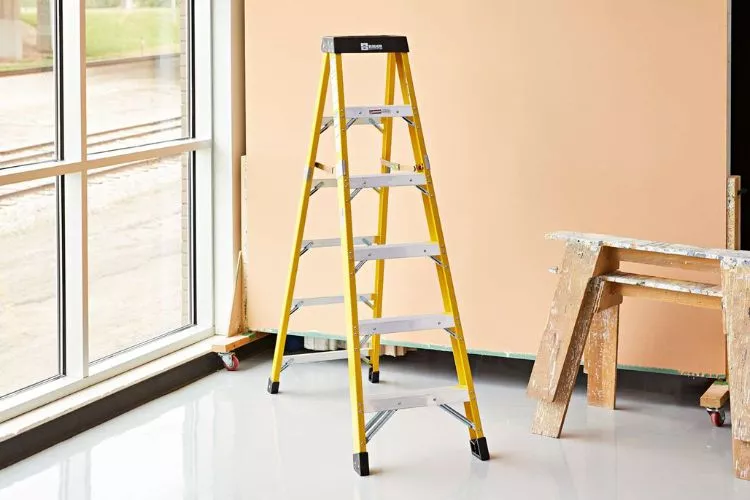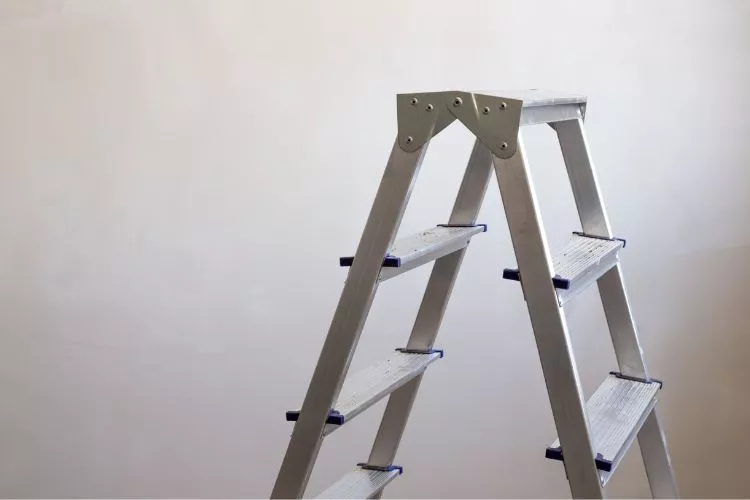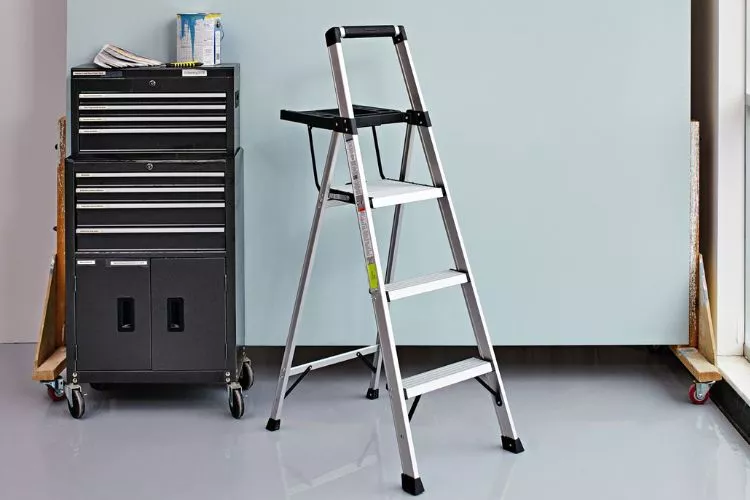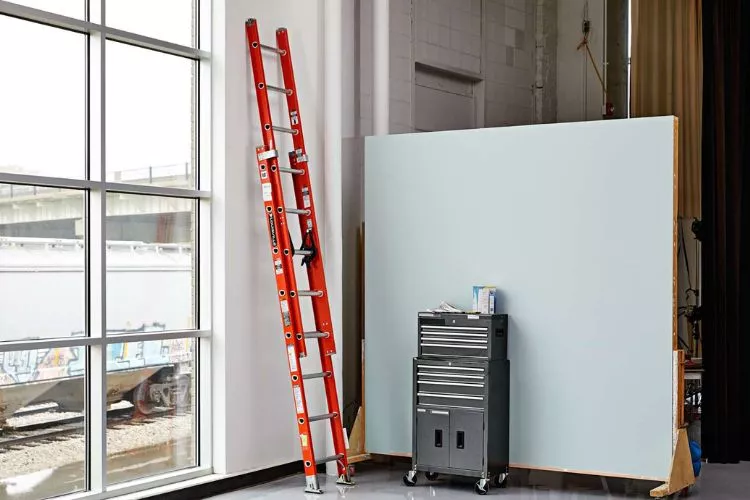Step ladders are versatile tools, commonly found in homes and workplaces, serving various purposes such as reaching high shelves, changing light bulbs, or conducting maintenance tasks. They are appreciated for their compact design and ease of use.
However, one important consideration when using step ladders, especially in outdoor settings or challenging environments, is their resistance to weather conditions.
So, are step ladders weather resistant?
In this comprehensive article, we’ll delve into the weather resistance of step ladders, covering different types of step ladders, the impact of weather on these tools, and how to ensure they remain weather-resistant.

Are Step Ladders Weather Resistant?
Step ladders’ weather resistance depends on the materials and construction. Aluminum and fiberglass step ladders are inherently weather-resistant due to their corrosion-resistant properties.
These materials can withstand exposure to rain, sunlight, and humidity without significant degradation.
However, wooden step ladders, unless treated and sealed properly, are less weather-resistant and can be susceptible to moisture-related issues like rot and decay.
To enhance weather resistance, many step ladders come with protective coatings, such as powder coating or anodization, and weather-resistant features like non-slip surfaces and rubber feet. Proper maintenance, including regular cleaning and storage in a dry area, can further extend their weather resistance.
In summary, while step ladders can be weather-resistant, it’s essential to consider the material, coatings, and maintenance practices to ensure they remain durable and safe in various weather conditions.
Understanding Step Ladders

Types of Step Ladders
Step ladders come in several different types, each designed to serve specific purposes:
- Folding Step Ladders: These are the most common type of step ladders, known for their compact, foldable design. Folding step ladders are ideal for indoor use and occasional outdoor tasks.
- Extension Step Ladders: These ladders can be extended to different heights, making them suitable for reaching elevated areas. They are commonly used in construction and outdoor projects.
- Platform Step Ladders: Platform step ladders are characterized by their large, stable platform at the top. They offer more workspace and are often used for tasks requiring both hands, such as painting or electrical work.
Common Materials Used in Step Ladders
The materials used in step ladders play a crucial role in determining their weather resistance:
- Aluminum: Aluminum step ladders are lightweight, durable, and naturally resistant to corrosion. They are a popular choice for outdoor tasks, thanks to their ability to withstand exposure to various weather conditions.
- Fiberglass: Fiberglass step ladders are electrically non-conductive and provide excellent resistance to moisture and chemicals. These ladders are commonly used in environments where weather resistance is a priority.
- Wood: While wood can provide a classic and aesthetically pleasing look, it is less weather-resistant compared to aluminum and fiberglass. However, treated wood step ladders can still offer decent protection against the elements.
Weather and Its Effects on Step Ladders
Weather can significantly impact the durability and safety of step ladders. Here are some factors to consider:
Factors That Affect Step Ladders in Weather
- Rain: Exposure to rain can lead to rust and corrosion in certain ladder materials, compromising their structural integrity.
- Sunlight (UV exposure): Prolonged exposure to sunlight can cause materials to weaken and become brittle over time, especially plastic components.
- Extreme Temperatures: Extreme heat or cold can affect the stability of step ladders, causing materials to expand or contract, potentially leading to cracks or warping.
- Humidity: High humidity levels can accelerate the corrosion of metal parts and degrade wooden components over time.
Consequences of Exposing Step Ladders to Weather
- Rust and Corrosion: Rust can weaken metal parts, making the ladder unsafe to use. This is a significant concern for steel or untreated aluminum ladders.
- Material Degradation: Exposure to weather can cause materials to weaken, crack, or lose their structural integrity, jeopardizing user safety.
- Safety Risks: Weather-damaged ladders can be dangerous to use. Loose or weakened rungs and rails can lead to accidents and injuries.
Weather Resistance in Step Ladders
To ensure the weather resistance of step ladders, it’s essential to consider the materials, coatings, and features that enhance their durability:

Weather-Resistant Materials
- Aluminum and Its Advantages: Aluminum step ladders are naturally corrosion-resistant due to the formation of a protective oxide layer on their surface. They are an excellent choice for outdoor use.
- Fiberglass and Its Advantages: Fiberglass ladders are non-conductive, making them safe to use around electrical hazards. They are also highly resistant to moisture and chemicals.
- Treated Wood: While wood is generally less weather-resistant, treated wood step ladders are available with coatings that can improve their durability and resistance to weather conditions.
Protective Coatings and Finishes
- Powder Coating: Powder coating is a durable finish that provides an extra layer of protection against corrosion. It’s commonly used on aluminum step ladders.
- Anodization: Anodized aluminum has a thicker, more protective oxide layer, further enhancing its weather resistance.
- Epoxy Coating: Epoxy coatings create a strong, moisture-resistant barrier that can be applied to various ladder materials.
Weather-Resistant Features
- Non-Slip Surfaces: Weather-resistant step ladders often have non-slip surfaces on the steps and platform to ensure stability, even in wet conditions.
- Rubber Feet: Rubber feet provide traction and stability on various surfaces, helping prevent slips and falls.
- Weather Seals: Some ladders come with weather seals or gaskets that help keep out moisture and prevent rusting of metal components.
- Reinforced Joints: Sturdy and well-secured joints are crucial for maintaining the ladder’s stability, especially when subjected to outdoor conditions.
Benefits of Weather Resistance
- Prolonged Lifespan: Weather-resistant step ladders tend to have a longer lifespan, saving you money in the long run.
- Enhanced Safety: Using a ladder that remains structurally sound in all weather conditions reduces the risk of accidents and injuries.
- Reduced Maintenance: Weather-resistant ladders typically require less maintenance, as they are less prone to damage from the elements.
Maintenance Tips for Weather-Resistant Step Ladders
Ensuring that your weather-resistant step ladder stays in excellent condition requires proper care:

Cleaning and Washing
Regularly clean the ladder, removing dirt, debris, and moisture. For aluminum and fiberglass ladders, a mild detergent can help remove grime without damaging the surface. Wooden ladders should be cleaned and dried thoroughly to prevent rot.
Storage
Store your step ladder in a dry, sheltered area when not in use. Protect it from direct sunlight and rain by keeping it indoors, in a shed, or under a cover.
Inspection and Maintenance Schedule
Regularly inspect your ladder for signs of wear, rust, or damage. Address any issues promptly to ensure it remains safe and weather-resistant. Set up a maintenance schedule to keep your ladder in top condition.
Pro Tips for Weather-Resistant Step Ladder Use
- Proper Storage- Store your step ladder in a dry, sheltered location when not in use to prolong its lifespan.
- Regular Inspection- Periodically inspect your ladder for signs of wear, damage, or rust, and address any issues promptly.
- Applying Protective Coatings- Consider applying additional protective coatings or finishes to your ladder to enhance its weather resistance.
- Avoiding Exposure to Extreme Weather- Whenever possible, avoid using your ladder in extreme weather conditions to minimize wear and tear.
Frequently Asked Questions (FAQs)
Can I leave my step ladder outside in the rain?
While some step ladders are more weather-resistant than others, it’s generally not advisable to leave any ladder exposed to rain for extended periods. Water can lead to rust and material degradation over time. Storing your ladder indoors or in a sheltered area is the best way to maintain its weather resistance.
How do I protect my wooden step ladder from the weather?
To protect a wooden step ladder from the weather, ensure it is made from treated wood. Regularly apply a weather-resistant wood finish or sealant to prevent moisture absorption and decay. Store it indoors or under cover when not in use.
Are all aluminum step ladders weather-resistant?
Aluminum step ladders are naturally weather-resistant to some extent due to their corrosion-resistant properties. However, some may have additional protective coatings, like powder coating or anodization, to enhance their weather resistance further. Check the ladder’s specifications to be sure.
Can I paint my step ladder for added weather protection?
Yes, you can paint your step ladder to add an extra layer of protection against the elements. Ensure you use a paint suitable for the ladder material and follow the manufacturer’s guidelines for proper application.
What is the maximum temperature range a step ladder can withstand?
The maximum temperature range a step ladder can withstand depends on the materials used. Fiberglass ladders are known to have a broader temperature tolerance, making them suitable for both hot and cold environments. Always check the manufacturer’s specifications for temperature limits.
Conclusion:
In conclusion, the weather resistance of step ladders is a crucial consideration to ensure both their longevity and your safety. Understanding the different types of step ladders, materials, and protective features available can help you make an informed choice.
By following proper maintenance practices and pro tips, you can ensure that your step ladder remains in excellent condition and ready for use, regardless of the weather conditions it may encounter.


